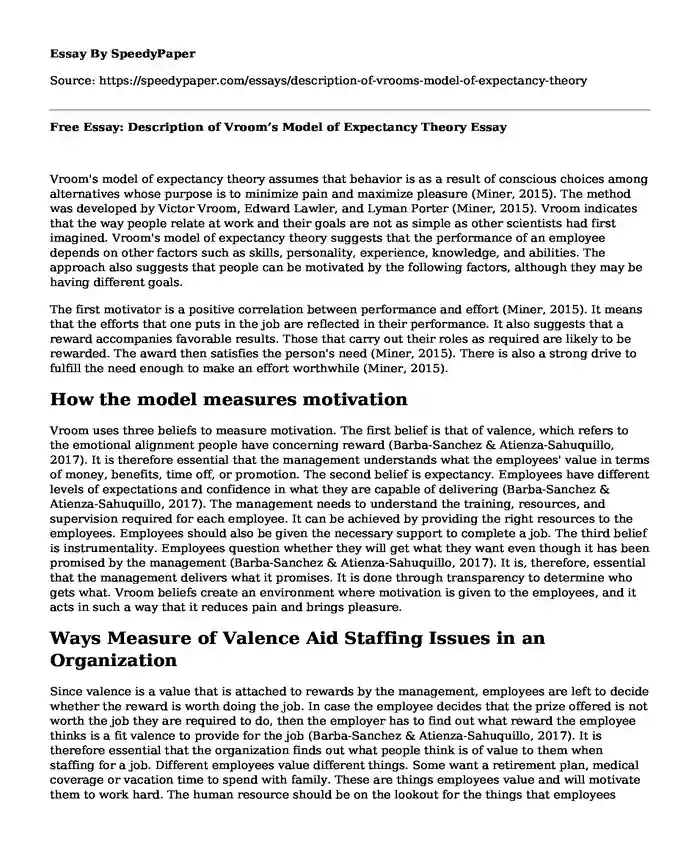
| Type of paper: | Essay |
| Categories: | Human resources Motivation Relationship Organizational behavior |
| Pages: | 3 |
| Wordcount: | 666 words |
Vroom's model of expectancy theory assumes that behavior is as a result of conscious choices among alternatives whose purpose is to minimize pain and maximize pleasure (Miner, 2015). The method was developed by Victor Vroom, Edward Lawler, and Lyman Porter (Miner, 2015). Vroom indicates that the way people relate at work and their goals are not as simple as other scientists had first imagined. Vroom's model of expectancy theory suggests that the performance of an employee depends on other factors such as skills, personality, experience, knowledge, and abilities. The approach also suggests that people can be motivated by the following factors, although they may be having different goals.
The first motivator is a positive correlation between performance and effort (Miner, 2015). It means that the efforts that one puts in the job are reflected in their performance. It also suggests that a reward accompanies favorable results. Those that carry out their roles as required are likely to be rewarded. The award then satisfies the person's need (Miner, 2015). There is also a strong drive to fulfill the need enough to make an effort worthwhile (Miner, 2015).
How the model measures motivation
Vroom uses three beliefs to measure motivation. The first belief is that of valence, which refers to the emotional alignment people have concerning reward (Barba-Sanchez & Atienza-Sahuquillo, 2017). It is therefore essential that the management understands what the employees' value in terms of money, benefits, time off, or promotion. The second belief is expectancy. Employees have different levels of expectations and confidence in what they are capable of delivering (Barba-Sanchez & Atienza-Sahuquillo, 2017). The management needs to understand the training, resources, and supervision required for each employee. It can be achieved by providing the right resources to the employees. Employees should also be given the necessary support to complete a job. The third belief is instrumentality. Employees question whether they will get what they want even though it has been promised by the management (Barba-Sanchez & Atienza-Sahuquillo, 2017). It is, therefore, essential that the management delivers what it promises. It is done through transparency to determine who gets what. Vroom beliefs create an environment where motivation is given to the employees, and it acts in such a way that it reduces pain and brings pleasure.
Ways Measure of Valence Aid Staffing Issues in an Organization
Since valence is a value that is attached to rewards by the management, employees are left to decide whether the reward is worth doing the job. In case the employee decides that the prize offered is not worth the job they are required to do, then the employer has to find out what reward the employee thinks is a fit valence to provide for the job (Barba-Sanchez & Atienza-Sahuquillo, 2017). It is therefore essential that the organization finds out what people think is of value to them when staffing for a job. Different employees value different things. Some want a retirement plan, medical coverage or vacation time to spend with family. These are things employees value and will motivate them to work hard. The human resource should be on the lookout for the things that employees value during employee interviews and annual employee evaluations. An organization is hence, able to keep its employees happy by determining the things they value or motivating them.
Conclusion
Vroom's Model of Expectancy theory shows how an individual behaves depending on what motivation they have. The reason can be in terms of rewards such as promotion, vacation, medical cover, and other benefits. The theory shows the processes that people undergo when making decisions. It is also essential that during staffing in an organization, the human resource should consider the different things that motivate individuals to do good work and maintain it. The organization should ensure that the rewards are deserved and wanted by the employee.
References
Barba-Sanchez, V., & Atienza-Sahuquillo, C. (2017). Entrepreneurial motivation and self-employment: evidence from expectancy theory. International Entrepreneurship and Management Journal, 13(4), 1097-1115.
Miner, J. B. (2015). Expectancy theories: Victor Vroom and Lyman Porter and Edward Lawler. In Organizational Behavior 1 (pp. 110-129). Routledge.
Cite this page
Free Essay: Description of Vroom's Model of Expectancy Theory. (2023, Feb 02). Retrieved from https://speedypaper.net/essays/description-of-vrooms-model-of-expectancy-theory
Request Removal
If you are the original author of this essay and no longer wish to have it published on the SpeedyPaper website, please click below to request its removal:
- Essay Example on Nuclear Waste Problem
- Free Essay on Employee Satisfaction and Work Motivation in Engineering Company
- Free Sample of a Literature Review on the Role of Neurotransmitters in Motivation and Learning
- Free Essay in American History: The Plans of American Reconstruction
- Project Management Cover Letter, Free Example for You
- Ethical and Social Responsibility Essay Example
- Paper Example. Increasing Healthy Eating in Children
Popular categories




